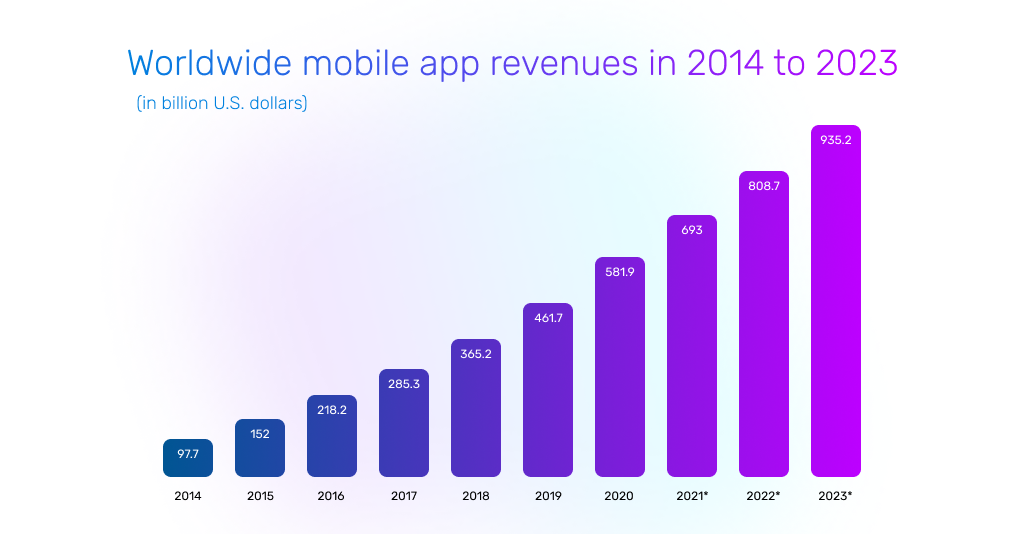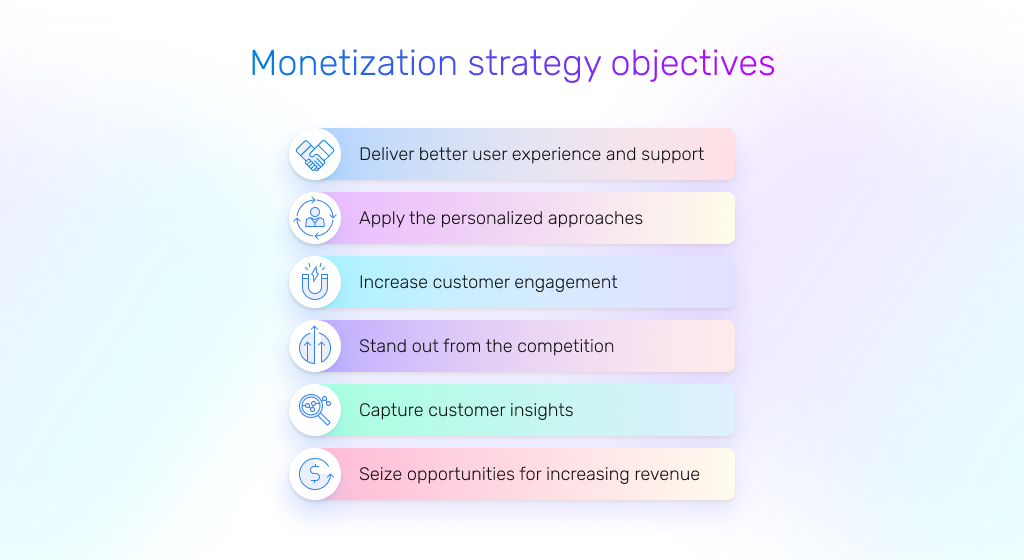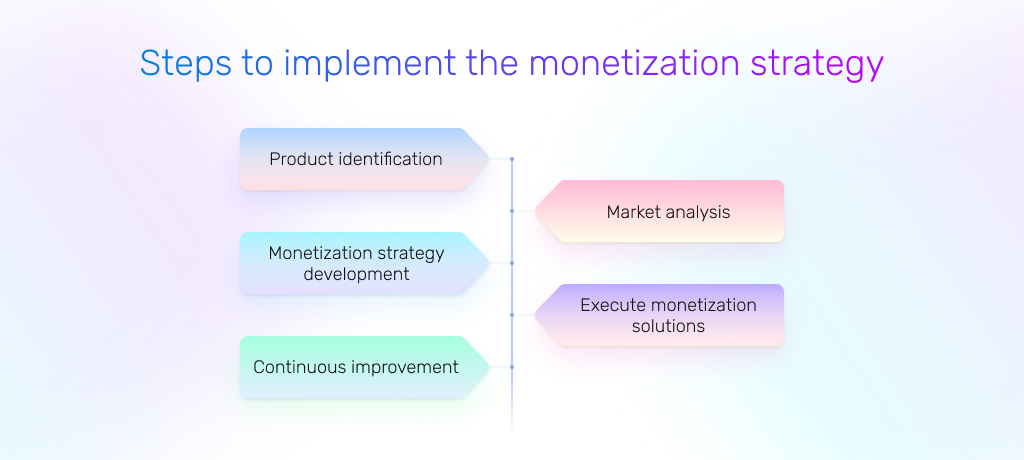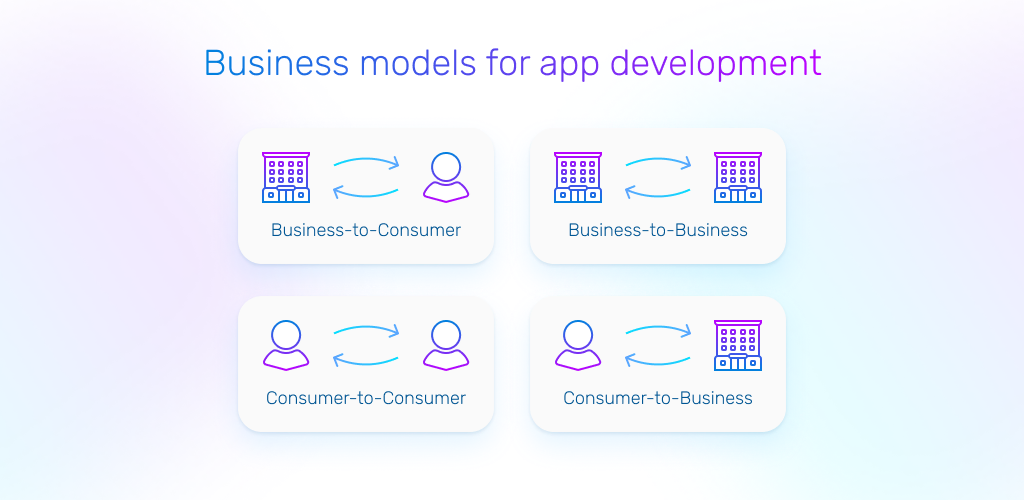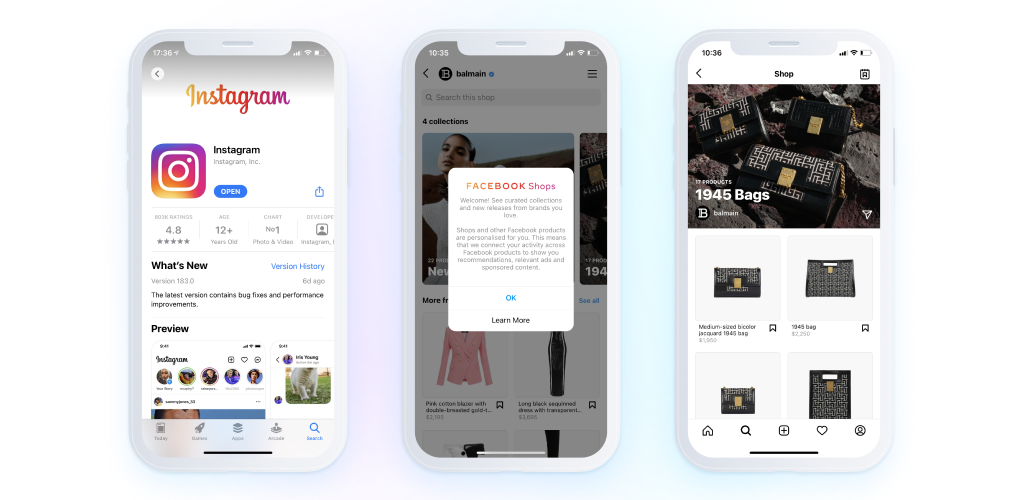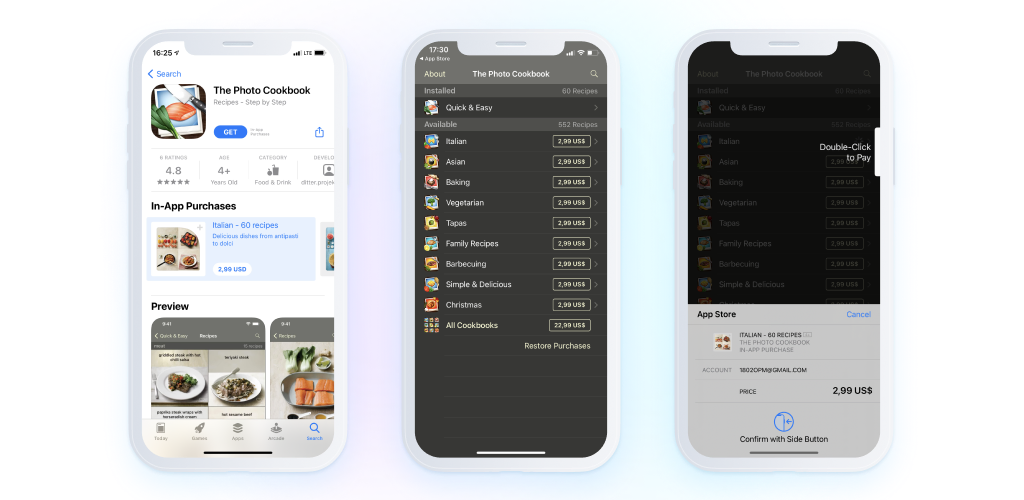
Updated: July 1, 2024
Published: May 6, 2021
Looking for an efficient solution to deliver user experience and build strong connections with your audience? How does the monetization strategy relate to the success of app development? How to maximize your revenue and provide advanced products and services? These and many other questions we’re going to address in our article about app monetization strategies. Let’s find out about available monetization models for apps and discover the best market practices.
List of the Content
- Why do you need a monetization strategy
- Monetization strategy objectives
- What is a monetization strategy
- Types of app monetization strategies
- How to choose the best app monetization strategy?
- In conclusion
WHY DO YOU NEED A MONETIZATION STRATEGY?
Everyone agrees that the business success depends on how well they arrange engagement with customers. Companies put a lot of effort into delivering a good user experience and establishing strong connections. It takes some time to build the products and services around the customers’ needs and reach the primary business goals.
Speaking about mobile app development, it has become a great way to broaden market coverage. Companies build applications for a variety of reasons. Some acknowledge the efficiency of acquiring new users and retaining the loyal ones engaged. The mobile app can serve as the extension of the business platform or become a service or product itself. Moreover, businesses apply apps as the marketing channel to distribute products and services among customers.
Therefore, app development itself is only halfway to presenting the product at the market. It is not completed without an efficient mobile app monetization strategy. Its adoption allows the team to explain one more reason for building mobile apps – revenue generation for businesses. The monetization strategy helps to outline how to make a profit from the value the company offers to its users via the application.
According to the statistics, global mobile app revenue is going to reach 693 billion U.S. dollars in 2021. It has been an increasing tendency over the last decade and continues into the coming years.
The need to build the mobile app is driven both by user requirements and market demand. According to the statistics, 92.6 percent of active users access the internet via mobile devices. That’s when active Internet users number more than half of the global population.
Going mobile is no more a choice but a necessity for any business. It opens new opportunities, including an excellent source of profit. When the company develops the mobile app, they have to build the best app monetization strategy around their user and company’s needs. Only a well-defined plan can point to efficient ways to earn money for your business.
The thing is that all mobile monetization models can come across as perfect solutions if appropriately selected. Some apps make money by displaying advertisements within the app. The others offer the paid services by adding premium features, subscriptions, and in-app purchases. Therefore, the monetization strategy aims at finding the best solution for your specific app. It will keep track of user engagement, support marketing campaigns, present unique offers, and increase profit.
Planning is the key moment of any process. That’s why pursuing the goal of earning a fortune starts with building the best app monetization strategy. It focuses on step-by-step idea implementation into the quality product that is required for any app development. In this article, we are going through all necessary details for software monetization solutions, check the best market practices, and learn how to monetize apps of different categories. Let’s start with the main objectives of the app monetization strategies.
MONETIZATION STRATEGY OBJECTIVES
The effective monetization strategy depends on the customer needs and the company’s ability to predict the rapidly changing market conditions. When approaching app development, the team should consider many business aspects. It is worth noting that defining the monetization strategy is as important as choosing your application’s tech stack. Companies have all the chances to turn app development to their advantage, like Flutter application development services that allow the team to build one product for both OSes. Flutter apps are known for advanced functionality, native performance, lower development, and maintenance cost. Moreover, all development aspects are tightly interconnected and have a mutual impact on your product’s success. The team can only build the best app monetization strategy along with defining all other requirements and needs.
Looking for more details about mobile app development?
Check our latest article about custom mobile applications with a step-by-step guide to the development process.
Monetization is so different from the one it’s used to be. Converting your software into revenue is a good business opportunity but could become a struggling task if not addressed properly. It is important to accept the fact that making revenue is only one of the monetization strategy objectives. The teams have to explore the question on a more experiential level instead of thinking transactionally.
The monetization strategy should focus on providing the best customer experience. Thus it will foster stronger relationships and increase user retention. The companies have to work a lot on building real value for their customers. They are in business to make a profit though it is impossible without building connections with the target audience. So let’s consider some of the key moments to reach your monetization strategy objectives.
- Deliver better user experience and support
It is nothing new that the way you arrange interactions with customers influences your product or service’s general impression. Meeting user expectations improves usability and allows the team to deliver excellent performance and functionality. The effective mobile app monetization strategy always focuses on building smooth, accessible, and valuable experiences. Customers are more likely to make a purchase when they are satisfied with your app’s overall experience.
- Apply the personalized approaches
That is a perfect opportunity to develop stronger connections with your brand. Customer-driven approaches facilitate interaction within your audience. Moreover, developing a mobile app is building a direct marketing channel. The great monetization models for apps embrace a highly personalized user experience and present suitable offers.
- Increase customer engagement
It is impossible to build a monetization strategy without supporting customer engagement. The team has to find ways for continuous engagement with their target market. The more often users interact with your app, the more inclined they are to purchase from you. It is not easy to make users return to your app again and again but definitely achievable by offering something valuable and special for them.
- Stand out from the competition
We need to admit the market competition gets tougher and customers are picky these days. Learn the market even before starting app development. Do customers have app alternatives? How will you distinguish your software from others? What is unique about your solutions and offers? The team can turn the monetization strategy to good advantage and take fresh ideas for feature implementation.
- Capture customer insights
As you increase customers’ understanding of your products and services, make sure to capture their preferences. Collected and analyzed feedback helps you make the right strategic decisions. It is important to use data-driven approaches while building an efficient monetization strategy.
- Seize opportunities for increasing revenue
It is great to consider good practices of app monetization and implement them within your project. Though you have a perfect opportunity to create additional methods to earn, for example, discovering a new customer segment or presenting the extra paid feature.
Combining these objectives with individual project goals helps to open new business opportunities. While discovering the variety of software monetization solutions, the team will be ready to make way for the best app monetization strategy.
WHAT IS A MONETIZATION STRATEGY
Building the app business model requires the knowledge of some basic principles. Even if the companies apply different monetization methods, they take similar steps for the strategy definition and implementation. It is thus essential to describe the mobile app monetization strategy in detail and explain how to undergo this process.
In simple words, app monetization strategies focus on presenting a plan to generate revenue via the app for your business. There isn’t one suitable solution for every project. Companies have to learn how to be both specific and flexible about their plans. The monetization models evolve along with changing market conditions and arising customer needs. It is one of the requirements to be ready to improve software monetization models continuously.
Another thing is that it should be closely linked to the development process of your application. The included functionality can open possibilities for new revenue streams, whereas some app monetization models will require building special features. It is important to oversee these needs from the beginning and ensure moving your product in the right direction.
Finding how to monetize software isn’t a straightforward task. The team has to cover several fundamental steps to implement the monetization strategy.
Identify a product
Before the team looks for the app monetization models, they need to have a clear vision of their product and services. It is illogical to think about pricing strategy if you don’t have something to offer for your customers. In fact, these are parallel processes where you brainstorm ideas for product development and the app business model. It is better to adopt the complementary approach to identify project needs and requirements.
Learn the market and add unique components
The mobile app monetization strategy should evolve alongside the customer needs and market demands. No matter how great the app is, it faces increasing competition. Not only do the startups need fresh ideas, but well-known market representatives have to strengthen positions with constant updates. The market analysis is an efficient step to validate the app idea and form reasonable offers for potential customers.
Develop a monetization strategy
This stage aims to identify the project priorities and guide the team on how to write a business plan for a mobile app or any other software. Data collected and analyzed in the previous stages help to support strategic planning. The team works out the specific plan, chooses app monetization models and pricing strategies.
Strategy execution
Software monetization models can be put into play after the app launch at the market. Tech specification and actual development are inevitable parts for preceding to monetize your app. One of the proven approaches is to focus on step-by-step implementation. The first release never presents the final product. It is important to advance the user experience by extending existing solutions. You need to give users a choice and continue attracting them with reasonable offers.
Continuous improvement
Building the application is only the beginning of the market journey. To withstand the tough competition, the company has to stay up-to-date including the technology choice like leveraging Flutter application development services. App monetization models are no exception. You need to adapt and improve the monetization strategy by seeking out customers’ feedback and learning market trends.
Have a great idea for a mobile application?
Feel free to contact our team. EXISTEK has first-hand experience to share with you. We provide full-cycle development services to build sophisticated products for our clients.
Any monetization strategy is based on organizing the business relationship between involved parties. We’ll need to draw attention to the business model you’ll build your product and services around. It clarifies how you can conduct business and what app monetization models are suitable for potential users. With that type of division, it is easier to define the target market and learn how to offer products and services.
The Business-to-Consumer model defines the process of offering products or services directly to the ultimate consumers. Purchases are made for their own use, and transactions are conducted between them and the company itself. For example, Facebook, Netflix, Amazon are referred to as B2C companies.
The Business-to-Business model differs on the final consumer. It means that services and products are delivered to other businesses but not individual customers. As a rule, they offer products that aim at improving the internal business processes. We can mention such B2B companies as Slack, Verizon, TripAdvisor.
The Consumer-to-Consumer model is quite popular among users. That means that the company creates a channel for exchange between customers. As a result, you can find various solutions where customers can offer their products and services. For instance, Uber, eBay, Airbnb are well-known representatives of C2C businesses.
The Consumer-to-Business model presents opportunities for users to sell services and products to businesses. It is a great distribution channel to make offers by individuals. Job hiring services or providing stock images are great examples. Adobe Stock, Upwork, Fiverr are known for applying C2B approaches.
TYPES OF APP MONETIZATION STRATEGIES
The monetization strategy embraces various aspects like defining plan steps, choosing the business model, etc. However, it can’t be completed without selecting suitable software monetization solutions. Continuing on how to write a business plan for a mobile app, we’re going to check the available app monetization models. Companies can use the strategy of their choice, whereas each of the following models creates its core. It allows the team to unify all the necessary parts and build them seamlessly into the user experience.
What is a monetization model?
App monetization models define the ways companies can drive revenue growth via mobile applications. It is usually conducted through the app functionality, content, delivered services, etc.
The essential point is that you need to choose monetization models for apps before the actual definition stage starts. It is easier to build the monetization strategy around it and outline the necessary functionality to implement. That is the same situation as with the product definition. When you know what you have for your customers, you’ll find a way to make money out of it.
It’s worth mentioning that the same mobile monetization models can be chosen for different industries and app categories. It is more about finding ways to offer products and services for customers and how to adapt the competitive pricing policy.
Building the monetization strategy around the free model
Let’s start with the free model, where users pay neither for downloading nor using an application. The first thing coming to mind is that it isn’t suitable for monetization at all. However, we’d recommend spending more time learning this app business model and finding its benefits to the monetization strategy.
Its adoption depends on the primary needs of the company. It helps to increase awareness for your application and gain a larger user base. It won’t be surprising that most businesses offer the app download for free. According to the statistics, free apps’ distribution makes up 92.9% in the App Store and 96.7% in Google Play.
It is caused by the reason that customers are more likely to download the free app instead of paying ahead. Most users want to gain some experience first and learn on their own how the app can be useful for them.
Therefore, the free model is a great starting point for presenting the new product and services by someone new to the market. They will be able to target their audience, test the app on the market and improve it based on user feedback. They consider this model a good possibility to evolve the product and later move to some other models, such as the freemium one.
On the contrary, the others continue using methods to raise revenue besides charging customers. A lot of companies earn by putting advertisements within their apps. They can choose among the variety of ways to display it. The free applications often contain native ads, smart banners, interstitial ads, video ads, rewarded videos, etc. It mostly works for the applications where users tend to spend a long time, for example, game or social media apps. Some customers can even appreciate the relevant and appropriate advertisements. Everything just depends on how well the monetization strategy overlooks user experience and targets in the right context. If you decide to use ads in your app, high quality should become the primary focus. It is important not to interrupt the user journey with annoying or inappropriate content. Instead, you can preserve the user experience by adding ads as a part of your content. For instance, Instagram shows ads in the form of stories, photos, or videos in the feed. It is always specified by user behaviors, interests, location, demographics, etc. Also, Instagram has curated collection ads shared by Facebook shops for presenting brand releases. This way allows the companies to target their content in the right audience.
The free model can seem to be the easiest way to build the mobile app monetization strategy. But if it misses strategic planning and right targeting, there is a good chance to annoy users with constant ads. That can even result in impacting the user experience negatively or even customers deleting the app.
App monetization strategies using the freemium model
It is an important moment that companies have to put their app monetization strategies in perspective and find more effective solutions than just ads. Freemium applications have a wide variety of options for monetizing your app as you can create them specifically. As a result, it embraces many business opportunities with high user engagement rates.
This model is quite popular due to its primary idea. The freemium apps are at no charge to download but offer in-app purchases. It covers the advantages of the free model as well as forms its own revenue streams. Many teams prefer that option as they make money on the particular app features, content, digital goods, etc. In their turn, users receive the functionality that is enough to meet general needs. The common practice is to present the basic set of features for free. And if users want to advance the experience or get some additional features, they will pay for it.
With this model, the monetization strategy can embrace so many variants for offering in-app purchases. The idea is that you need to present something that your users would like to buy. The offers are formed depending on the general product idea, the app category, available functionality, and user needs. For example, the cooking app can include paid packages of recipes categorized for vegetarian, Italian cuisine, holiday edition for Christmas, etc.
The complicated task is that you need to embrace the experience of both paying and non-paying users. The primary feature set has to show the real value and encourage customers to purchase from you. As the final choice is after users, you need to understand that not everyone is going to spend money within your app. But the experience you offer for non-paying customers influences the overall success of your product.
It is worth mentioning that this model might not be suitable for every app. If you don’t plan to add new content regularly, it can have some adverse effects. It is essential that this monetization model evolves with time. Users should observe how their experience gets improved with every purchased product.
Also, the monetization strategy based on this model should embrace some good marketing campaigns. For better efficiency, the team can use the data gathered on the user experiences, customer preferences, and made purchases. Both iOS and Android have in-build analytic tools that measure your app’s monetization and business performance, including pre-orders, sales, etc.
The subscription model as a core of the monetization strategy
When the team plans on software monetization solutions, they’re looking for a steady source of income. If we take advertising or in-app purchases, it could be more challenging to guarantee a constant revenue stream. For example, pay from advertising can depend on click-through rates. At the same time, in-app purchases are one-time payments and usually used for an unlimited duration.
The subscription model has evolved as the new category of in-app purchasing. It is a quite similar concept when the users download the app for free but pay for delivered services and products based on chosen subscriptions. It is common to present several plans and target different user needs. Some companies differentiate subscriptions by the duration, prices, and access levels. As a result, most apps can even present separate plans for particular user groups like basic or premium customers.
As with previous app monetization models, every user still gets some content without paying. The teams set limitations to certain features or conditions using them. For example, news applications limit reading time or the number of articles a day. If users want to read more, they can purchase the subscription with unlimited reading access.
Many applications practice the trial period to get their customers acquainted with the offered services. However, it is not recommended to make it longer than a month. One week for a trial period will be enough as the users discover the product value and get interested in prolonging this experience.
As for the income stream, subscriptions are the most predictable and recurring revenue options. Customers get access on an ongoing basis due to the defined service plan and duration. Also, you have to consider the renewing options. If the customer chooses the non-renewing one, they will need to buy the new plan manually every time the previous one finishes. On the contrary, an auto-renewable subscription allows users to automatically renew and pay unless they cancel the plan.
The monetization strategy helps to set certain terms for content updates, learn user preferences and work towards necessary improvements. Besides enhancing user experience, the team aims to find unique value for their audience and build long-lasting relationships. The app business model built around subscriptions always enables the better retention of customers. It focuses on individual approaches and oversees each customer’s needs in particular. The more loyal users you have, the more profit you can get.
The paid model for the monetization strategy
Getting back to the app distribution, the percentage of paid applications remains quite small. According to the statistics, it is only 3.3% in Google Play and 7.1% in the App Store. But it doesn’t mean that the model isn’t suitable for the monetization strategy. Even if it has only one stream revenue, the paid app can become an efficient and profitable solution for many teams.
The main concept is that users pay once for the download and have full access to the app content. This app business model is often presented as premium services with no extra charges. It provides the possibility for customers to have an experience that won’t be limited or interrupted by any other offers.
In order to develop the best app monetization strategy there, the team has to find a way to attract customers. It is obvious that they could hesitate about the value proposition and not be ready to pay ahead even without trying the app. Therefore, your monetization strategy should include strategic marketing and even apply for cross-promotional tools.
Like with any other model, the companies need to put a lot of effort into acquiring new users. However, it is a more challenging task for paid apps. If the other models count more on the gained experience within the app, these ones have to attract customers beforehand.
There are a number of things that speak volumes to the target audience. It is the case where the smallest details matter. Always get ready to present your product in the app stores – starting from the catchy logo and title to the full description of included functionality. Make sure to add the preview and screenshots showing the main app features. The fact is that you retain customers before they get acquainted with the product. The next steps include meeting user expectations and continuing the advancement of the app content.
As for other monetization opportunities, the paid applications are often delivered as an addition to existing solutions. The App Store even offers the paid app bundles to purchase a few apps at once. It is great for companies that develop separate apps to meet users’ needs specifically. For example, the music maker bundle can include several apps like multitrack and hip hop studios. Thus, users can purchase individual apps or get all the apps in the bundle at once for a lower price.
App monetization strategies with the paymium model
As you notice, some monetization models evolve by adding new components to the existing ones. Companies often prefer to combine several options within their strategies. It allows them to attract more users and turn a better profit.
The paymium model is a combination of the paid app and the premium monetization approaches. That means that users both pay the download fee and have the possibility to make in-app purchases. Additional paid services are subjects to improve user experience and get them more engaged with your products.
It is worth mentioning that paymium apps should deliver excellent performance, beautiful designs, and a unique user experience. Some users might not expect the additional purchases as they’ve already paid for the download. Unless you meet their expectations with the main content, it will be difficult to get them interested in new offers.
This model appeared by extending the paid app concept. It’s obvious that several sources of income are always better. Download fees aren’t so high if we compare revenue driven through purchases. Provided that the monetization strategy of paymium apps is built around the users’ needs, teams have all the chances to present the value propositions that they can’t reject.
It is quite important to deliver a well-planned pricing strategy. For example, teams tend to reduce the download charges though focusing on monetization via in-app offers. Special offers, discounts have always been popular among users. You can group paymium apps in the bundle in the App Store and sell them for an attractive price.
Another thing to take into consideration is competition. Paid applications always have a wide range of free alternatives. Customers wouldn’t like to pay for the same app functionality if they can get it for free. Paymium apps should be premium products from the first tap the user makes. Otherways, it affects negatively not only the user experience but sales rates.
The premium service delivery will require more time and resources. It overlooks the development of the complex application powered by the latest trends. Simple apps have little chance to compete in this category. Therefore, this model isn’t suitable for every project, especially when you are new to the market. When you apply some monetization model, you need to observe its efficiency constantly. Sometimes it happens that the team has to switch between. For example, developers are able to change the paid app to the free selection in Google Store. Though, the free applications are not allowed to be changed to free ones.
As we’ve gone through available models, let’s get into more details on how to choose your best app monetization strategy.
Have additional questions or need professional advice?
At EXISTEK, we know how to build mobile applications with meeting user expectations and leveraging the best market practices.
HOW TO CHOOSE THE BEST APP MONETIZATION STRATEGY?
Mobile app development has opened new opportunities to establish strong connections with customers. Whether you start a new app or extend the existing user experience, it is always a great option to strengthen the market position. Moreover, it allows you to find additional revenue streams. For many, the profit they earn from the application has also become one of the ways to measure the project’s success. The more popular application gets, the more revenue you can earn with it. That is a vital task for the whole team to work together on the monetization strategy and find the most reasonable approaches. The strategy efficiency will depend on numerous aspects and how well they manage to arrange the overall process.
As we come to the question of the best app monetization strategy, there won’t be one correct answer. The fact is that every team has to build its strategic plan aiming at the project needs and requirements. Of course, it’s good to check the best market practices and learn more about your competitors’ experience. It can become a good basis to start, whereas individual goals should be taken into account as well. The complementary approach is the best option since the companies have to follow the market trends and find a way to differentiate their products and services from others.
It is important to remember that app functionality will stay at the core of each mobile app monetization strategy. Based on planned features, it is easier to choose the business models and implement them within your project. Presented functionality should draw your potential customers’ attention and be turned into constant revenue streams. It is important to overlook how to make the value propositions within your app. Learning customers’ needs and expectations can define various offers to get users engaged with an application.
It is worth mentioning that both free and paid apps have the capacity to generate good profits. The monetization models tend to evolve with time, meeting new customer expectations and rising market demands. Software improvements aim at better app functionality and performance and new opportunities for getting higher revenue. Getting back to the monetization models, we can say that teams can either stay with one model or combine several of them.
That’s just the matter of choice and how well it goes with your business requirements and needs. If you want to provide continuous value for users, it is essential to have a free great basic version and continue advancement with some paid premium features, goods, content, etc. When you are service-oriented and have the top quality functionality at the core, it will be nice to offer subscriptions to have constant and predictable revenue streams.
As a result, the monetization strategy has become an inevitable part while starting software development. It involves the strategic plan to bring your products and services to the market and constantly advance the engagement with the target audience.
IN CONCLUSION
It goes without saying that building a mobile presence is a necessity for any business. Today’s market is full of opportunities to make stronger connections with customers and get them engaged with your products and services. At the same time, mobile solutions have presented new options to generate revenues for businesses.
We hope that this article has helped you to learn how to write a business plan for a mobile app, including helpful advice on choosing the best app monetization strategy for your business.
Need to choose the best app monetization strategy?
The EXISTEK team has extensive experience in mobile app development. We know how to implement your ideas into successful solutions and help you make a profit out of them.
Frequently asked questions
How to monetize software?
The market has many approaches to making a profit within mobile applications. Their methods vary from in-app advertisements to more sophisticated solutions like paid features, content, and subscriptions. The team's main task will be to form an efficient app monetization strategy that helps find suitable approaches and choose the right app business model.
How to develop the monetization strategy?
The application's success also depends on the efficiency of the app monetization strategies. In order to deliver a well-defined plan, the team has to go through the following steps:
Identify the product
Learn the market and add unique components
Develop the monetization strategy
Strategy execution
Continuous improvement
What is a monetization model?
The monetization model helps to define the ways how companies can generate revenue via software. It often uses a set of approaches to earn from delivered services, features, and content. Moreover, each model outlines business relationships with customers.
What are monetization models applied in mobile app development?
Depending on the business needs and requirements, the company can choose among several options. Whereas the final choice should be based on the well-defined mobile app monetization strategy. Here are the top 5 app monetization models:
Free model
Freemium model
Subscription model
Paid model
Paymium model

